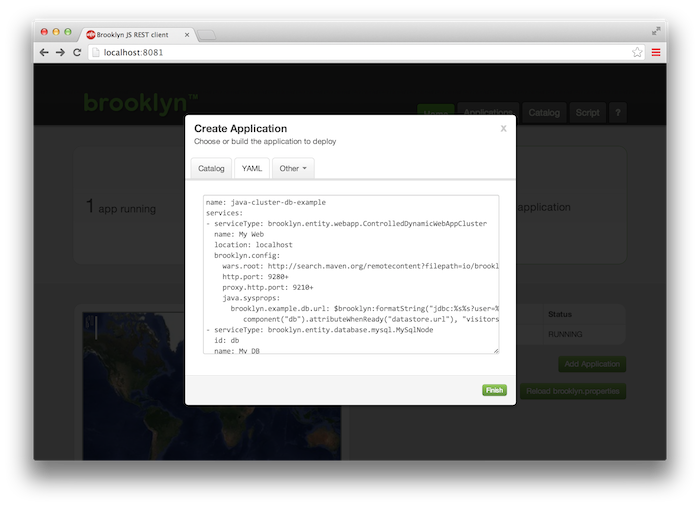The Basic Structure
A First Blueprint
The easiest way to write a blueprint is as a YAML file. This follows the OASIS CAMP plan specification, with some extensions described below. (A YAML reference has more information, and if the YAML doesn’t yet do what you want, it’s easy to add new extensions using your favorite JVM language.)
The Basic Structure
Here’s a very simple YAML blueprint plan, to explain the structure:
name: simple-appserver
location: localhost
services:
- type: brooklyn.entity.webapp.jboss.JBoss7Server-
The
nameis just for the benefit of us humans. -
The
locationspecifies where this should be deployed. If you’ve set up passwordless localhost SSH access you can uselocalhostas above, but if not, just wait ten seconds for the next example. -
The
servicesblock takes a list of the typed services we want to deploy. This is the meat of the blueprint plan, as you’ll see below.
Finally, that clipboard in the corner lets you easily copy-and-paste into the web-console:
simply download and launch Brooklyn,
then in the “Add Application” dialog at the web console
(usually http://127.0.0.1:8081/.
There are several other ways to deploy, including curl and via the command-line,
and you can configure users, https, persistence, and more,
as described in the ops guide.
More Information
Topics to explore next on the topic of YAML blueprints are:
Plenty of examples of blueprints exist in the Brooklyn codebase,
so another starting point is to git clone it
and search for *.yaml files therein.
Brooklyn lived as a Java framework for many years before we felt confident to make a declarative front-end, so you can do pretty much anything you want to by dropping to the JVM. For more information on Java:
- start with a Maven archetype
- see all Brooklyn Java guide topics
- look at test cases in the codebase
You can also come talk to us, on IRC (#brooklyncentral on Freenode) or any of the usual hailing frequencies, as these documents are a work in progress.
